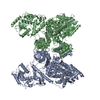+ Open data
Open data
- Basic information
Basic information
| Entry | Database: PDB / ID: 9c6q | |||||||||||||||||||||||||||||||||||||||||||||||||||||||||||||||
|---|---|---|---|---|---|---|---|---|---|---|---|---|---|---|---|---|---|---|---|---|---|---|---|---|---|---|---|---|---|---|---|---|---|---|---|---|---|---|---|---|---|---|---|---|---|---|---|---|---|---|---|---|---|---|---|---|---|---|---|---|---|---|---|---|
| Title | Structure of V. cholerae monomeric DdmD bound with ssDNA | |||||||||||||||||||||||||||||||||||||||||||||||||||||||||||||||
 Components Components |
| |||||||||||||||||||||||||||||||||||||||||||||||||||||||||||||||
 Keywords Keywords | IMMUNE SYSTEM/DNA / DNA defense modules(Ddm) / DdmDE / Vibrio Cholerae / bacteria / anti-plasmid / IMMUNE SYSTEM-DNA complex | |||||||||||||||||||||||||||||||||||||||||||||||||||||||||||||||
| Function / homology | DNA / DNA (> 10) / Helicase/UvrB N-terminal domain-containing protein Function and homology information Function and homology information | |||||||||||||||||||||||||||||||||||||||||||||||||||||||||||||||
| Biological species |  | |||||||||||||||||||||||||||||||||||||||||||||||||||||||||||||||
| Method | ELECTRON MICROSCOPY / single particle reconstruction / cryo EM / Resolution: 3.18 Å | |||||||||||||||||||||||||||||||||||||||||||||||||||||||||||||||
 Authors Authors | Shen, Z.F. / Yang, X.Y. / Fu, T.M. | |||||||||||||||||||||||||||||||||||||||||||||||||||||||||||||||
| Funding support | 1items
| |||||||||||||||||||||||||||||||||||||||||||||||||||||||||||||||
 Citation Citation |  Journal: Cell / Year: 2024 Journal: Cell / Year: 2024Title: DdmDE eliminates plasmid invasion by DNA-guided DNA targeting. Authors: Xiao-Yuan Yang / Zhangfei Shen / Chen Wang / Kotaro Nakanishi / Tian-Min Fu /  Abstract: Horizontal gene transfer is a key driver of bacterial evolution, but it also presents severe risks to bacteria by introducing invasive mobile genetic elements. To counter these threats, bacteria have ...Horizontal gene transfer is a key driver of bacterial evolution, but it also presents severe risks to bacteria by introducing invasive mobile genetic elements. To counter these threats, bacteria have developed various defense systems, including prokaryotic Argonautes (pAgos) and the DNA defense module DdmDE system. Through biochemical analysis, structural determination, and in vivo plasmid clearance assays, we elucidate the assembly and activation mechanisms of DdmDE, which eliminates small, multicopy plasmids. We demonstrate that DdmE, a pAgo-like protein, acts as a catalytically inactive, DNA-guided, DNA-targeting defense module. In the presence of guide DNA, DdmE targets plasmids and recruits a dimeric DdmD, which contains nuclease and helicase domains. Upon binding to DNA substrates, DdmD transitions from an autoinhibited dimer to an active monomer, which then translocates along and cleaves the plasmids. Together, our findings reveal the intricate mechanisms underlying DdmDE-mediated plasmid clearance, offering fundamental insights into bacterial defense systems against plasmid invasions. | |||||||||||||||||||||||||||||||||||||||||||||||||||||||||||||||
| History |
|
- Structure visualization
Structure visualization
| Structure viewer | Molecule:  Molmil Molmil Jmol/JSmol Jmol/JSmol |
|---|
- Downloads & links
Downloads & links
- Download
Download
| PDBx/mmCIF format |  9c6q.cif.gz 9c6q.cif.gz | 256.7 KB | Display |  PDBx/mmCIF format PDBx/mmCIF format |
|---|---|---|---|---|
| PDB format |  pdb9c6q.ent.gz pdb9c6q.ent.gz | 200.4 KB | Display |  PDB format PDB format |
| PDBx/mmJSON format |  9c6q.json.gz 9c6q.json.gz | Tree view |  PDBx/mmJSON format PDBx/mmJSON format | |
| Others |  Other downloads Other downloads |
-Validation report
| Summary document |  9c6q_validation.pdf.gz 9c6q_validation.pdf.gz | 1.3 MB | Display |  wwPDB validaton report wwPDB validaton report |
|---|---|---|---|---|
| Full document |  9c6q_full_validation.pdf.gz 9c6q_full_validation.pdf.gz | 1.3 MB | Display | |
| Data in XML |  9c6q_validation.xml.gz 9c6q_validation.xml.gz | 55.8 KB | Display | |
| Data in CIF |  9c6q_validation.cif.gz 9c6q_validation.cif.gz | 81.7 KB | Display | |
| Arichive directory |  https://data.pdbj.org/pub/pdb/validation_reports/c6/9c6q https://data.pdbj.org/pub/pdb/validation_reports/c6/9c6q ftp://data.pdbj.org/pub/pdb/validation_reports/c6/9c6q ftp://data.pdbj.org/pub/pdb/validation_reports/c6/9c6q | HTTPS FTP |
-Related structure data
| Related structure data |  45254MC  9bf1C  9bf5C  9bgkC M: map data used to model this data C: citing same article ( |
|---|---|
| Similar structure data | Similarity search - Function & homology  F&H Search F&H Search |
- Links
Links
- Assembly
Assembly
| Deposited unit | 
|
|---|---|
| 1 |
|
- Components
Components
| #1: DNA chain | Mass: 3597.367 Da / Num. of mol.: 1 / Source method: obtained synthetically / Source: (synth.)  |
|---|---|
| #2: Protein | Mass: 136155.328 Da / Num. of mol.: 1 Source method: isolated from a genetically manipulated source Source: (gene. exp.)   |
| Has protein modification | N |
-Experimental details
-Experiment
| Experiment | Method: ELECTRON MICROSCOPY |
|---|---|
| EM experiment | Aggregation state: PARTICLE / 3D reconstruction method: single particle reconstruction |
- Sample preparation
Sample preparation
| Component | Name: Monomeric complex of V. cholerae DdmD bound with ssDNA Type: COMPLEX / Entity ID: all / Source: RECOMBINANT |
|---|---|
| Source (natural) | Organism:  |
| Source (recombinant) | Organism:  |
| Buffer solution | pH: 8 |
| Specimen | Embedding applied: NO / Shadowing applied: NO / Staining applied: NO / Vitrification applied: YES |
| Vitrification | Cryogen name: ETHANE |
- Electron microscopy imaging
Electron microscopy imaging
| Experimental equipment |  Model: Titan Krios / Image courtesy: FEI Company |
|---|---|
| Microscopy | Model: FEI TITAN KRIOS |
| Electron gun | Electron source:  FIELD EMISSION GUN / Accelerating voltage: 300 kV / Illumination mode: FLOOD BEAM FIELD EMISSION GUN / Accelerating voltage: 300 kV / Illumination mode: FLOOD BEAM |
| Electron lens | Mode: BRIGHT FIELD / Nominal defocus max: 2500 nm / Nominal defocus min: 500 nm |
| Image recording | Electron dose: 50 e/Å2 / Film or detector model: GATAN K3 (6k x 4k) |
- Processing
Processing
| Software | Name: PHENIX / Version: 1.21_5207: / Classification: refinement | ||||||||||||||||||||||||
|---|---|---|---|---|---|---|---|---|---|---|---|---|---|---|---|---|---|---|---|---|---|---|---|---|---|
| EM software | Name: PHENIX / Category: model refinement | ||||||||||||||||||||||||
| CTF correction | Type: NONE | ||||||||||||||||||||||||
| 3D reconstruction | Resolution: 3.18 Å / Resolution method: FSC 0.143 CUT-OFF / Num. of particles: 568349 / Symmetry type: POINT | ||||||||||||||||||||||||
| Refine LS restraints |
|
 Movie
Movie Controller
Controller







 PDBj
PDBj






































